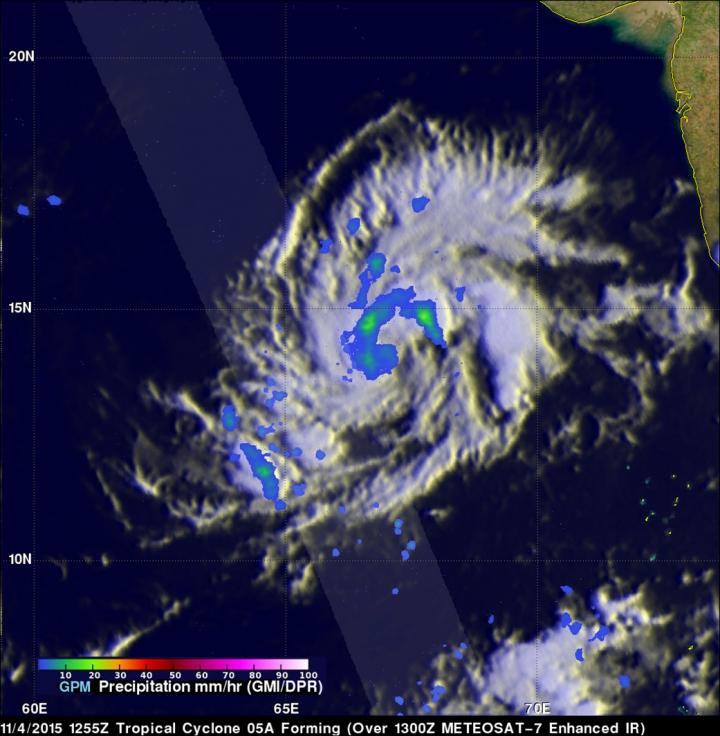NASA spots another Arabian Sea tropical cyclone forming

NASA/JAXA's GPM satellite measured scattered light to moderate rainfall in Tropical Cyclone 05A on Nov. 4, falling at a maximum rate of only 23.3 mm (.92 inches) per hour. Credits: NASA/JAXA/SSAI, Hal Pierce
Deadly tropical cyclone Chapala had just dissipated over Yemen when tropical cyclone 05A started forming in the warm waters of the Arabian Sea west of India.
GPM measured the rainfall within the forming tropical cyclone using the satellite's Microwave Imager (GMI) and Dual-Frequency Precipitation Radar (DPR) instruments. GMI and DPR found that 05A had scattered light to moderate rainfall falling at a maximum rate of only 23.3 mm (.92 inches) per hour.
GPM is an international mission led by NASA and the Japan Aerospace Exploration Agency to observe rainfall and snowfall around the world. The program is managed by NASA's Goddard Space Flight Center in Greenbelt, Maryland.
On November 5, 2015 at 1500 UTC (10 a.m. EST), Tropical Cyclone 05A was located near 13.9 degrees north latitude and 63.9 degrees east longitude, about 546 nautical miles (628.7 miles/ 1,012 km) east of Socotra Island, Yemen.
Tropical Cyclone 05A is moving to the west at 10 knots (11.5 mph/18.5 kph). It is a tropical storm with maximum sustained winds near 35 knots (40 mph/64.8 kph).
The tropical storm is expected to track over the island of Socotra on Nov. 8 with tropical storm force winds while heading west.
The Joint Typhoon Warning Center (JTWC) predicts that 05A will head toward Cape Gardafui, Somalia, move into the Gulf of Aden and make landfall in southeastern Yemen north of Aden, Yemen on Nov. 10.
Media Contact
All latest news from the category: Earth Sciences
Earth Sciences (also referred to as Geosciences), which deals with basic issues surrounding our planet, plays a vital role in the area of energy and raw materials supply.
Earth Sciences comprises subjects such as geology, geography, geological informatics, paleontology, mineralogy, petrography, crystallography, geophysics, geodesy, glaciology, cartography, photogrammetry, meteorology and seismology, early-warning systems, earthquake research and polar research.
Newest articles

A universal framework for spatial biology
SpatialData is a freely accessible tool to unify and integrate data from different omics technologies accounting for spatial information, which can provide holistic insights into health and disease. Biological processes…

How complex biological processes arise
A $20 million grant from the U.S. National Science Foundation (NSF) will support the establishment and operation of the National Synthesis Center for Emergence in the Molecular and Cellular Sciences (NCEMS) at…

Airborne single-photon lidar system achieves high-resolution 3D imaging
Compact, low-power system opens doors for photon-efficient drone and satellite-based environmental monitoring and mapping. Researchers have developed a compact and lightweight single-photon airborne lidar system that can acquire high-resolution 3D…





















